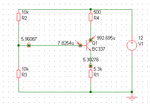tahir4awan
Full Member level 4
Someone asked question in forum about Transistor Hfe DC gain and I read a reply which stated that "Make Transistor circuit which is independent of Hfe". So they advice to use voltage divider bias.
If I accept that transistor circuit can be made independent of Hfe then all transistors are same despite their max ratings.
Hfe is the parameter which differentiates between different transistors.
You say that you can find value of Ic in voltage divider bias without using Hfe so it is independent of Hfe but I say can you find Ib in voltage divider bias without Hfe.
Transistor starts from base current and there is no Ic possible without Ib so only find value of IC in voltage divider bias doesn't mean that Ib is not important and if you consider Ib then you have to use Hfe
If I accept that transistor circuit can be made independent of Hfe then all transistors are same despite their max ratings.
Hfe is the parameter which differentiates between different transistors.
You say that you can find value of Ic in voltage divider bias without using Hfe so it is independent of Hfe but I say can you find Ib in voltage divider bias without Hfe.
Transistor starts from base current and there is no Ic possible without Ib so only find value of IC in voltage divider bias doesn't mean that Ib is not important and if you consider Ib then you have to use Hfe
